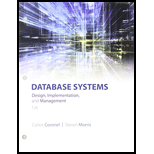
Concept explainers
Normalization:
The process used to minimize data redundancy and dependency in a relational
First normal form (1NF):
- If a table does not contain any replicate fields or groups of fields then that model is called as first normal form.
- In this form, entities do not contain any single instance of the repeating variable.
- It means that the entities contain only one instance of the attributes, multi-valued attributes are neglected.
Second normal form (2NF):
- The value of all non-primary key attributes should be dependent on the primary key attribute.
- If any attribute is depending on the partial primary key then it should determine the other attributes for an instance of the entity.
- The partial dependencies should be removed from the data model.
Third normal form (3NF):
- The value of any non-primary key attributes will not depend on any other non-primary key attributes.
- If any non-primary key attributes depend on any other non-primary key attribute then it should be moved or deleted.
- It is termed as transitive dependency.
Partial dependency:
A partial dependency exists at that time of an attributes depends only a part of primary key. This dependency is related with 1st normal form.
Transitive dependency:
A transitive dependency exists at that time of an attributes depends on another attribute which is not part of primary key.
Functional dependency:
An association between two attributes or two set of attributes in a same relational database table, which is having some constraints is known as functional dependency.
- In a table one attribute is functionally dependent on another attribute to take one value.
Trending nowThis is a popular solution!

Chapter 6 Solutions
Database Systems: Design, Implementation, Management, Loose-leaf Version
- I need helpt o resolve the following issuearrow_forwardI would like to know a brief explanation of basic project management concepts.arrow_forwardEX:[AE00]=fa50h number of ones =1111 1010 0101 0000 Physical address=4AE00h=4000h*10h+AE00h Mov ax,4000 Mov ds,ax; DS=4000h mov ds,4000 X Mov ax,[AE00] ; ax=[ae00]=FA50h Mov cx,10; 16 bit in decimal Mov bl,0 *: Ror ax,1 Jnc ** Inc bl **:Dec cx Jnz * ;LSB⇒CF Cf=1 ; it jump when CF=0, will not jump when CF=1 HW1: rewrite the above example use another wayarrow_forward
- EX2: Write a piece of assembly code that can count the number of ones in word stored at 4AE00harrow_forwardWrite a program that simulates a Magic 8 Ball, which is a fortune-telling toy that displays a random response to a yes or no question. In the student sample programs for this book, you will find a text file named 8_ball_responses.txt. The file contains 12 responses, such as “I don’t think so”, “Yes, of course!”, “I’m not sure”, and so forth. The program should read the responses from the file into a list. It should prompt the user to ask a question, then display one of the responses, randomly selected from the list. The program should repeat until the user is ready to quit. Contents of 8_ball_responses.txt: Yes, of course! Without a doubt, yes. You can count on it. For sure! Ask me later. I'm not sure. I can't tell you right now. I'll tell you after my nap. No way! I don't think so. Without a doubt, no. The answer is clearly NO. (You can access the Computer Science Portal at www.pearsonhighered.com/gaddis.)arrow_forwardStart with the initial angles within the integration and just integrate them without mapping them to specific quadrants. Use python and radiansarrow_forward
 Database Systems: Design, Implementation, & Manag...Computer ScienceISBN:9781285196145Author:Steven, Steven Morris, Carlos Coronel, Carlos, Coronel, Carlos; Morris, Carlos Coronel and Steven Morris, Carlos Coronel; Steven Morris, Steven Morris; Carlos CoronelPublisher:Cengage Learning
Database Systems: Design, Implementation, & Manag...Computer ScienceISBN:9781285196145Author:Steven, Steven Morris, Carlos Coronel, Carlos, Coronel, Carlos; Morris, Carlos Coronel and Steven Morris, Carlos Coronel; Steven Morris, Steven Morris; Carlos CoronelPublisher:Cengage Learning A Guide to SQLComputer ScienceISBN:9781111527273Author:Philip J. PrattPublisher:Course Technology Ptr
A Guide to SQLComputer ScienceISBN:9781111527273Author:Philip J. PrattPublisher:Course Technology Ptr Database Systems: Design, Implementation, & Manag...Computer ScienceISBN:9781305627482Author:Carlos Coronel, Steven MorrisPublisher:Cengage Learning
Database Systems: Design, Implementation, & Manag...Computer ScienceISBN:9781305627482Author:Carlos Coronel, Steven MorrisPublisher:Cengage Learning Principles of Information Systems (MindTap Course...Computer ScienceISBN:9781305971776Author:Ralph Stair, George ReynoldsPublisher:Cengage Learning
Principles of Information Systems (MindTap Course...Computer ScienceISBN:9781305971776Author:Ralph Stair, George ReynoldsPublisher:Cengage Learning
 Principles of Information Systems (MindTap Course...Computer ScienceISBN:9781285867168Author:Ralph Stair, George ReynoldsPublisher:Cengage Learning
Principles of Information Systems (MindTap Course...Computer ScienceISBN:9781285867168Author:Ralph Stair, George ReynoldsPublisher:Cengage Learning





